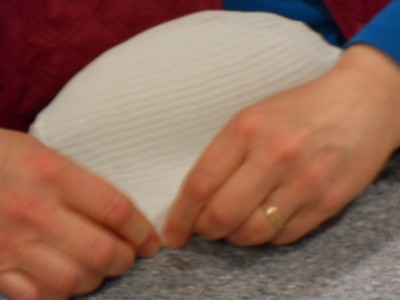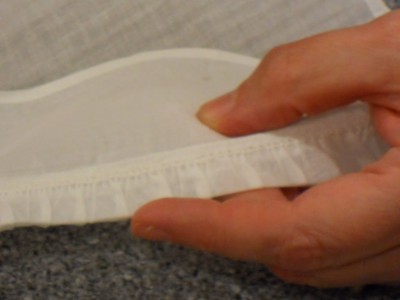Sally wrote: What are the customs of head coverings? I know they vary a bit from community to community, but on the “A Joyful Chaos” blog, Marianne said that she switched from a black one to a white one. I’ve seen little girls, however, wear white, so I’m guessing this is not a universal custom. Also, at what point would a girl begin to wear one?
Would I want to be Amish? I confess that the sense of community appeals to me, as does the simpler life. If I were born in it, I don’t know how I’d feel, but I do think I’d be awfully curious about what else there is besides Amish. I’ve always chafed at chauvenism, even though that mind-set was what I was taught, so I think the submissive / subservience of women would never have set well with me – whether or not I was born Amish.
Would I want to be Amish? I confess that the sense of community appeals to me, as does the simpler life. If I were born in it, I don’t know how I’d feel, but I do think I’d be awfully curious about what else there is besides Amish. I’ve always chafed at chauvenism, even though that mind-set was what I was taught, so I think the submissive / subservience of women would never have set well with me – whether or not I was born Amish.
The customs for head coverings indeed varies from one community to another. I can try to explain what these were in my home community. It would be interesting to find out how different/similar it might have been in Marianne’s community.
Girls wore head coverings from the time they were babies in my community. Young girls wore simple “koppa”, made from organdy material for “everyday.” For Sunday church services, we wore a more elaborate finely-pleated black kopp. Later, as young women begin to develop physically, they give up their little-girl dresses with buttons down the back for a “front-closing” dress, pinned down the front. At that same time, they also give up their simple black organdy kopp for a white, pleated organdy kopp for everyday. On Sundays and at weddings, however, they wear their black silk coverings, as they have since they were young.
The day an Amish woman gets married, she wears her black, silk head covering for the church service and the actual marriage ceremony. As soon as the service is over, she changes into her white organdy head covering, which she will wear all her married life. Changing from the black to the white on her wedding day is a physical symbol of going from being single to being married.
The pleated koppa were very elaborate in my home community. I don’t know of any other community in which the koppa were that elaborate.
Me trying to pleat a 33-year-old kopp.
Tonight I pulled out the covering I used to wear that I kept over the years. The pleats didn’t stay from 8 years ago, when last I pleated it. So, I tried ironing it and seeing if I could pleat it again, but it needs to be washed, starched, and ironed again. I think the material might be too old for it to “hold” the pleats. You basically fold it over, turn over the covering, and fold it again, like an accordion. it takes a lot of patience. Look at the detail that went into making this covering:
While I was going through my Amish mementos, I found the “hankies” I used to take to church with me. The young women “wore” these hankies in their pockets. Interesting that the fanciest things we had were tucked away in our pockets.
Sally, your questions were cause for me to go down memory lane. Thank you!






They were very pretty and delicate. Blessings, Joanne
I came from an Amish background as well. It’s quite interesting reading your blog! I think it’s great that you are telling your story.
Rudy
Saloma
Can you ‘read’ the different types of headcoverings and the differences in dress among the Amish so that you know where someone comes from? If you can, is something that comes easy or is it hard?
I suppose the color of the head covering would be the way to distinguish whether a woman is married or not since I believe I’ve read that the Amish do not exchange rings.
Have a Wonderful Weekend!
Angela
Yes, Marianne went from black to white when she was married.
Elin is asking what I also wanted to ask but didn’t want it to be too involved a question! … I notice there are different shapes and styles. Yours is quite intricate, with all those pleats! (and how interesting that the desire to have something pretty carries even within those who seek to be plain, stylin’ with hankies).
Thanks for answering my question. I’m enjoying this series very much.
– Sally
Thank you Joanne, Rudy, and Elin.
Rudy, which community did you come from? I’m always interested in hearing stories from other former Amish.
Elin, when I was still part of my original community, the answer is yes, I could read the clothing styles — at least the ones I was familiar with. However, since I’ve left, there are so many new communities that have been started, that there are now many I cannot identify by their clothing styles.
Thank you again for your comments and questions.
Saloma
I loved the photos in this blog. I see you are busy touring and sharing your story. Keep up the good work. Remember, idle hands are the “devil’s business”.
-aim
(former Mennonite)
Never before have I seen someone pleating a capp while wearing a wedding ring! Great shot!
I just heard an Amish woman say if she got into an accident and wasn’t wearing her head covering that she couldn’t get into heaven. Why did she say that? Do all Amish believe that way?
Interesting reading. As has been noted, Amish communities vary widely. Where I grew up (a small church in Oregon) and then later in Virginia in a church of several hundred families, our koppa/coverings were nothing like as intricate, although some of the women who came from more conservative communities like those in Somerset County in Pennsylvania tended to maintain their coverings in that distinctive style.
In Oregon, the coverings were smaller and neater than those in Pennsylvania, in both Somerset County and Lancaster County. Our coverings had virtually no excess material, unlike those that droop in the back or for that matter, the pleated ones. I’ve seen some pleated ones that were works of art, being not only pleated lengthwise but in a herring bone pattern. I have no idea how that was done!
Elva B.
Elva, in Geauga County where I came from, we had that “herringbone” pattern. I can actually do it… but it takes a long time.
It sounds like you grew up Amish. I didn’t even know there were Amish in Oregon… how interesting. I would love to hear from you. My email address is salomafurlong@gmail.com.
Saloma
I used to be a nun and the plainness of a nun’s life sounds very similar to the Amish. All our clothes were the same, we had no coloured curtains or doileys and we did all the chores around the house and farm to keep food on the table. We weren’t allowed to wear a watch on our wrist because that could be fancy, so they went on our belts under an apron. Every group of nuns has a different style of dress that is instantly recognisable to other nuns and to do something differently was unthinkable.
The comment about having a fancy handkerchief hidden away reminded me of a very cold winter. We used to get up to pray at night time but the sick or old sisters would sleep through the night. In the very cold winter it was too cold to go barefoot at night and to wear our shoes would wake the sick sisters so we got slippers. They were a huge extravagance. Mother looked everywhere to find plain slippers but slippers only come in “fluffy.” We all had to pretend not to be excited at such a worldly convenience. We never, ever wore the slippers in daylight. Technically we weren’t supposed to have slippers but charity was the most important thing of all.
I am on Amtrak’s Chicago-bound Empire Builder as I write (type) this. On each trip on this train, I notice and learn something new about my Amish (and Mennonite) sisters. Today I saw some of the women wearing a small, black headpiece, hanging off the head slightly in the back. When I asked about it, my newest friend told me it is called a Diechlich (I’m using a German spelling of what she said). She described it as a casual in-home headpiece that is worn in place of the starched white cap, as a more comfortable head covering that would not show dust and/or dirt as easily as the white cap would. This made a lot of sense to me, especially for such a long rail journey. I asked Katie-Ann and her new husband Dwayne about getting an Amish dress as travel apparel, and gave them my contact information, hoping they might talk it over with their community and maybe even keep in touch by letter, if it were deemed to be permissible.
Riding Amtrak with not-so-strict Amish and Mennonite friends has been a much better education than any field trip our non-Amish schools could possibly arrange. I hope leaders in our respective communities take notice, and promote this in some way. I will be doing my part!
Nice information. Why are the strings to the Kapp’s not used?
I was just wondering why the strings are not tied. Why have them at all? Tying them would help keep it in place, but untied they look like a nuisance.